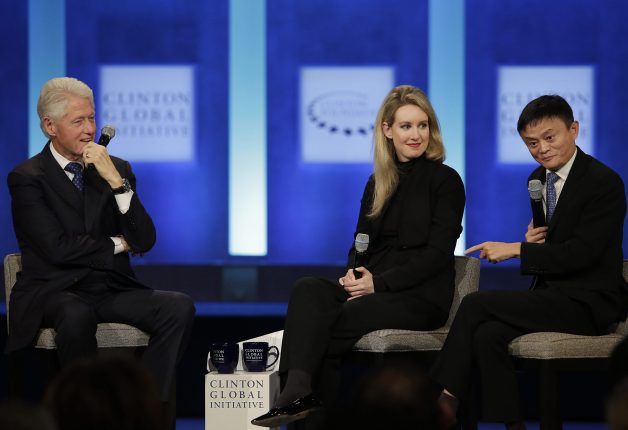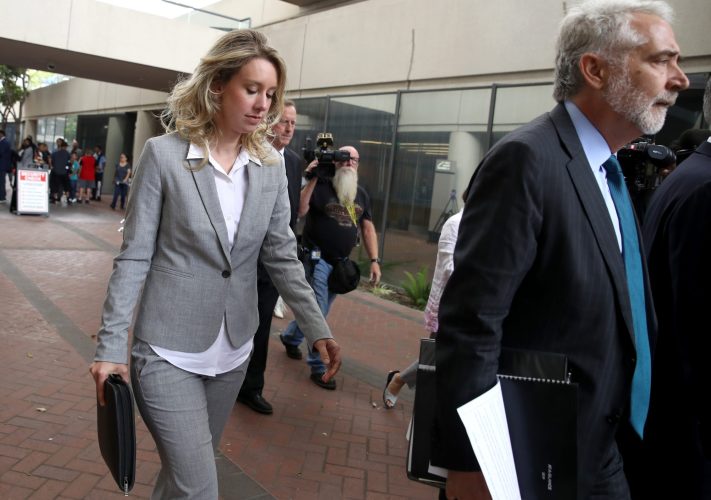In 2016, Forbes described Elizabeth Holmes, the founder and CEO of the blood-testing company Theranos, as “the world’s youngest self-made woman billionaire.” At the time, she was worth about $4.5 billion.
However, her thriving company came tumbling down after an investigative journalist from The Wall Street Journal exposed years of deceptive claims concerning the capabilities of her technology.
Holmes was charged with various counts of fraud by the Department of Justice and stepped down from her position as CEO in June 2018, a few months before the company formally shut down. Holmes’ federal fraud trial will begin in August 2020, and she faces up to 20 years in prison if convicted.
Here’s how Elizabeth Holmes rose to the top and how her company collapsed underneath her:
The ambition of young Elizabeth Holmes and the rise of Theranos
TRENDING: Trump Derangement Time Warp: Notorious Trump Critic Attacks Domino’s for 8-Year-Old Tweet
Holmes had sky-high aspirations from a very young age. According to CBS, when she was 9 years old, Holmes told her father in a letter that she wanted to “discover something new, something that mankind didn’t know was possible to do.”
Her dream of changing the world carried her to Stanford University. Holmes studied chemical engineering until she dropped out of school to start a company at the age of 19.
It was her fear of needles that gave her the idea to develop a device that could conduct a large number of tests using only a few drops of blood harvested from the prick of a finger. The device would be painless, needle-free and inexpensive for patients.
But when she brought the idea to her professors like Phyllis Gardner, a professor of medicine at Stanford, Holmes was told her idea wouldn’t work. As Gardner explained to Vanity Fair in 2016, a drop of blood from a finger prick could not provide comprehensive or accurate data.
Do you think Elizabeth Holmes should go to jail?
But Holmes moved forward with the idea and officially founded Theranos in 2003. As she became a rising star in the Silicon Valley tech industry, Holmes seemed to model her life and company after that of her idol, Steve Jobs.
As the business began to grow, Holmes adopted Jobs’ signature black turtleneck as her daily uniform. And just like Jobs ran Apple, security and secrecy within Holmes’ company was the name of her game.
According to Vanity Fair, Holmes held all the control as founder, CEO, and chairwoman of Theranos. Employees were not allowed to discuss their work with others inside the company, all visitors were forced to sign non-disclosure agreements, and lawyers were sent after employees who so much as mentioned their job description at Theranos.
In 2013, the company’s chief scientist, Ian Gibbons, soon discovered the inaccuracies of Holmes’ technologies. Even so, as Holmes worked to market the company to investors, Gibbons worked tirelessly to correct the technology.
When Gibbons reportedly warned Holmes that the technology was not ready to be released to the public, Holmes began opening “Theranos Wellness Centers” in Arizona Walgreens. However, according to another employee, Channing Robertson, Gibbons told him the technology was “sufficient to commercialize.”
Around that time, Theranos filed a lawsuit against a former neighbor and friend of Homes’ claiming he had stolen Theranos secrets. Gibbons was called upon to testify in the suit about the company’s technology, but refused.
His wife told Vanity Fair her husband did not want to testify because he didn’t want to harm the company by detailing its failings, but also didn’t want to leave patients in the hands of unreliable medical technology.
Holmes allegedly grew impatient with Gibbons’ unwillingness to testify, and a few months later, Gibbons received a call from Holmes’ assistant requesting he meet with Holmes the following day.
Gibbons became distraught, believing Holmes was going to fire him. That night, according to Gibbons’ widow, he attempted suicide, and died a week later in the hospital.

Former U.S. President Bill Clinton (L) and Theranos Founder and CEO Elizabeth Holmes listen as Alibaba Group Executive Chairman Jack Ma (R) speaks during the Clinton Global Initiative annual meeting in New York on Sept. 29, 2015. (Joshua Lott / AFP via Getty Images)
Holmes, meanwhile, continued to be invited to TED talks and esteemed panels, speaking alongside Bill Clinton, and began to be compared to her idol, Jobs.
It wasn’t until 2015 that people — specifically the Wall Street Journal’s John Carreyrou and investigators from federal health administrations — began to uncover the truth.
Theranos falters under investigation
According to Vanity Fair, investigators from the Food and Drug Administration arrived at the Theranos headquarters and blood-testing lab without warning in August 2015. Regulators from the Centers for Medicare and Medicaid Services visited the labs soon after.
Almost two months later, The Wall Street Journal’s investigative reporter John Carreyrou published an article exposing the discrepancies between what Holmes and Theranos said the technology could do and what it actually did.
The article exposed a number of deeply concerning medical practices, including suspicions of diluting blood samples, and shared stories of patients who experienced health scares because of inaccurate results from Theranos tests.
Holmes was left scrambling to preserve Theranos’ image. She appeared on CNBC‘s “Mad Money” to defend herself and her company, saying that WSJ had declined to look at Theranos technology even though the company had offered and that Theranos had sent the news company a 1,000-page document that debunked the allegations of Carreyrou’s story.
“This is what happens when you work to change things, and first they think you’re crazy, then they fight you and then all of a sudden you change the world,” she said.
“But we are doing things differently and we are working to make a difference and that means people raise questions, and that’s okay.”
But Carreyrou didn’t stop with one article. A slew of WSJ articles followed his initial article on Theranos, covering condemning developments such as U.S. health authorities’ investigation of complaints filed by former employees and erratic results from Theranos labs, as well as the FDA’s declaration that the tiny vials used to collect the blood samples were “uncleared medical devices.”
As Theranos technology went under the microscope and continually came up lacking, Holmes and her company were forced to backtrack.
In 2016, Theranos invalidated two years of test results and a criminal investigation was launched into the company. Federal health authorities banned Theranos from operating a lab in California and banned Holmes from the blood-testing industry for two years.
A few months later, Theranos stopped testing blood and let go of over 40 percent of its staff.
Elizabeth Holmes and Theranos fall under charges of fraud
Holmes did her best to save face as more companies and individuals sued and severed ties with Theranos. She continued to attend medical conferences and insisted that Carreyrou was to blame for the company’s downfall, according to Vanity Fair.
In 2018, the Securities and Exchange Commission filed a complaint against Holmes and Theranos in the U.S. District Court for the Northern District of California, charging them with “massive fraud.” The complaint suggested Holmes pay a penalty, give up her company voting rights and shares, and be banned from being an officer or director of any publicly-traded company for 10 years.
“Holmes, Balwani, and Theranos raised more than $700 million from late 2013 to 2015 while deceiving investors by making it appear as if Theranos had successfully developed a commercially-ready portable blood analyzer that could perform a full range of laboratory tests from a small sample of blood,” the complaint read.
“They deceived investors by, among other things, making false and misleading statements to the media, hosting misleading technology demonstrations, and overstating the extent of Theranos’ relationships with commercial partners and government entities, to whom they had also made misrepresentations.”
The SEC complaint also condemned Holmes and her company for claiming to run over 200 tests on Theranos technology when they only ran 12 tests on their own machines and outsourced the rest. The SEC pointed out that Holmes claimed that these tests did not need FDA approval even though the FDA sent her letters in 2014 saying that they did.
The SEC further alleged Holmes told investors that Theranos was projected to make over $100 million in revenue in 2014 and $1 billion in 2015, when in reality, Theranos made just over $100,000 in 2014.
By 2017, Theranos was at the brink of bankruptcy. According to the WSJ, Theranos subsequently laid off the majority of the company’s remaining employees.
The media swarms the story as Elizabeth Holmes pays retributions and awaits her trial
In 2018, Holmes paid a $500,000 penalty, gave up a substantial portion of her stock in Theranos and agreed not to lead a public company for 10 years under the SEC settlement.
Later that year, Holmes was charged with two counts of conspiracy to commit wire fraud and nine counts of wire fraud in federal court.
If convicted, Holmes could face up to 20 years in prison, a $250,000 penalty, and be forced to repay the damages caused to everyone who was defrauded.
Holmes stepped down as Theranos CEO in June 2018, according to CNBC. After surrendering to the FBI, Holmes and her former COO Ramesh “Sunny” Balwani were released on $500,000 bond each.
Theranos formally shut down a few months later while using their remaining funds to repay creditors, the WSJ reported.
Yet according to Vanity Fair, employees said Holmes was strangely happy even though her company was crumbling down around her. She would hug employees who had recently gone before the federal agencies charging the company, reportedly feeling confident that the company would be just fine.
A former employee said that Holmes only appeared upset once the company stopped financing her lifestyle.
Holmes awaits her trial in federal court, which is set to start on August 4 after being postponed because of the coronavirus, according to the U.S. Attorney’s Office for the Northern District of California.

Theranos founder and former CEO Elizabeth Holmes (L) leaves the Robert F. Peckham U.S. Federal Court on June 28, 2019, in San Jose, California. (Justin Sullivan / Getty Images)
Many have jumped at the chance to tell Holmes’ dramatic story: HBO released a documentary called “The Inventor: Out for Blood in Silicon Valley” which is now available on Hulu, and ABC released a podcast and a documentary on Holmes called “The Dropout.”
According to Harpers Bazaar, Jennifer Lawrence is set to star as Holmes in an adaptation of Carreyrou’s 2018 book, “Bad Blood: Secrets and Lies in a Silicon Valley Startup,” which covers his reporting on the Theranos founder in further detail.
We are committed to truth and accuracy in all of our journalism. Read our editorial standards.

